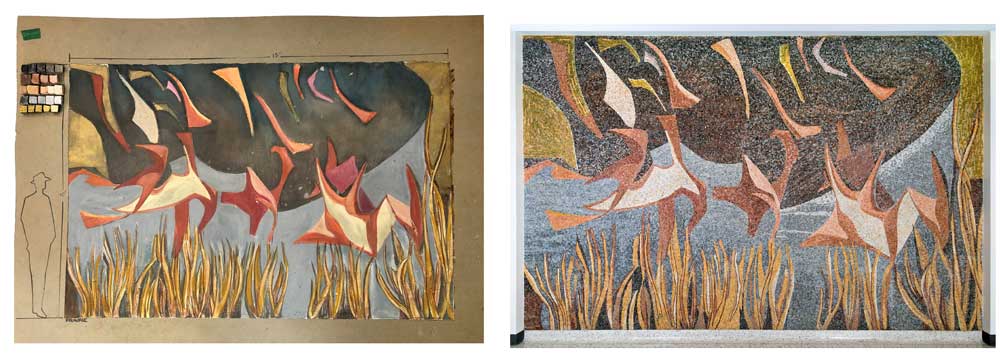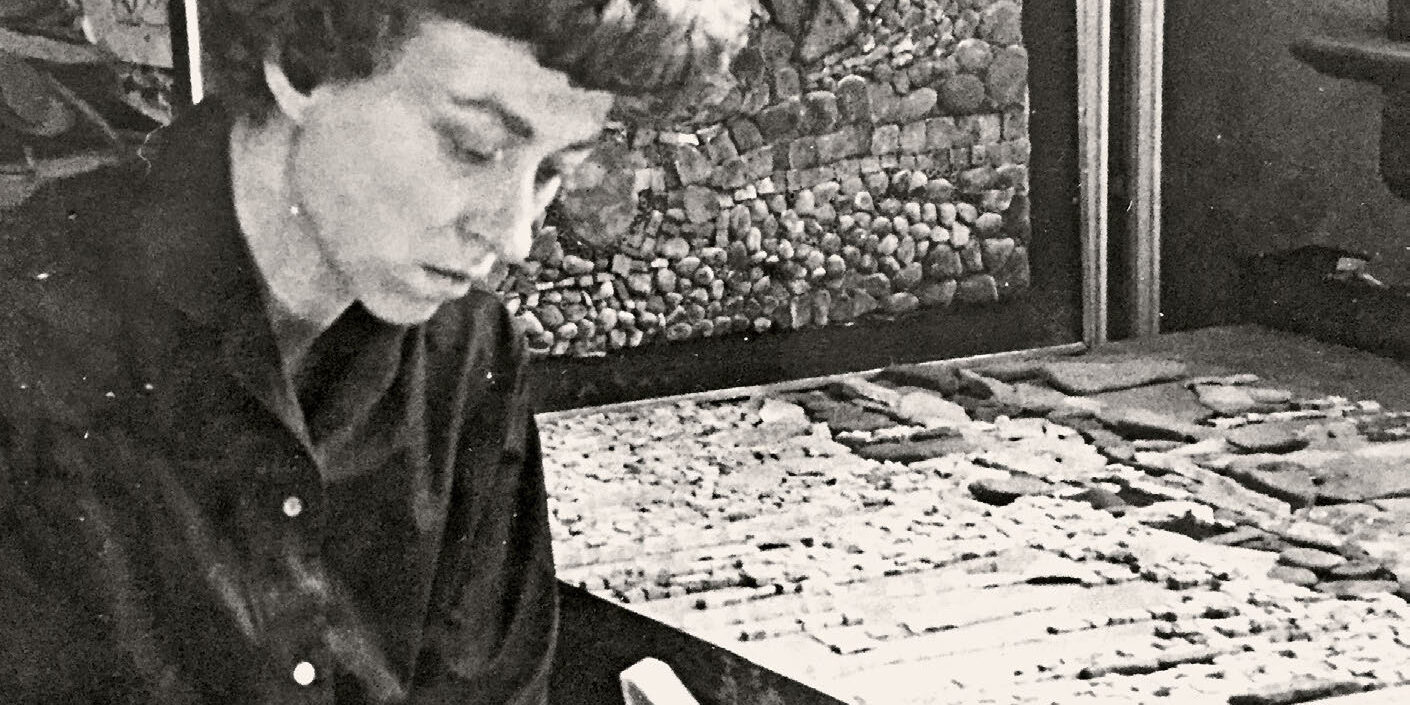MOSAIC is a tradition dating back more than 8,000 years, though, in our modern architectural environment, it often goes unnoticed. Modern mosaic has been virtually left out of art history as an area worthy of study.
Common Ground: Landscape Mosaics at the Wisconsin State Office Building in Milwaukee
Common Ground: Landscape Mosaics at the Wisconsin State Office Building in Milwaukee
Professor Marjorie Kreilick-McNab’s suite of 10 hand-cut marble and 24-karat gold smalti1 murals for the Wisconsin State Office Building in Milwaukee offers an opportunity for public education into this enduring art form.2
As Kreilick noted in a lecture about these mosaics, “As mosaicists, we belong to one of the oldest art traditions; a tradition of public patronage. Mosaic adornment intended for a specific architectural setting is an art for use. It has a definite purpose in adding splendor and symbolic significance to public architectures.”3
My aim in writing this article is to raise awareness of these unique Wisconsin mosaics, so those future generations may continue to benefit from the state’s cultural legacy.

TOP: Professor Marjorie Kreilick-McNab in her Wisconsin studio cutting marble with traditional mosaic tools, the hammer and hardie, 1960s. Courtesy M. Kreilick, all rights reserved. ABOVE: Coniferous Forest in winter snow with yellow-gold sky; sixth floor, Milwaukee State Office Building, Wisconsin, 1963. More than 65 kinds of marble came from quarries in Carrara, Italy. Photo © David Erickson, courtesy Wisconsin Historical Society.
An Exciting Discovery & A Timeless Technique
The 1963 State Office Building in downtown Milwaukee features warm and glowing mosaic murals. As I researched Kreilick’s archive,4 important original preparatory paintings and plans for the ten magnificent mosaics were found This discovery adds to the scholarship of these incredible midcentury works of art, and are significant to understand how the modern architectural mosaics were commissioned, fabricated, and integrated into the built environment. The small paintings are called a bozzetti or cartoons, and indicate scale and include sample material chosen for each mural. The section maps are color-coded and indicate how the sections were divided up into multiple crates or cassa for shipping. They are stamped with the fabrication studio monogram, Studio Mosaici Monticelli.

Milwaukee State Office Building, 1963, currently on the market for sale to private commercial developers. Vintage Postcard © L.L.Cook Co. from an Ektachrome transparency, courtesy Shimon and Lindemann’s Wisconsin Project.

The section map for Burning Prairies shows how the design was made in smaller pieces, similar to a puzzle, following the natural curves in the design to hide any seams. The color-coding indicates which sections were packed into the numbered crates so they could be identified and installed upon arriving in Milwaukee. Photo by Lillian Sizemore.
The state architect, Karel Yasko, commissioned Kreilick as the lead artist to collaborate with the architects, designers, and construction team on the new Wisconsin State Office Building. The architectural designers presented tentative plans, and they assigned the industries of beer, wood pulp, and milk as the intended subjects for the murals.
Kreilick, the only woman on the project, listened intently and then stated: “Gentlemen, I’m not interested in that.” She felt the imagery of an industrial world was “too unstable a subject matter for the permanence of marble mosaic.” She declined the job. Yasko quickly interceded by setting up another meeting at which Kreilick proposed her radically different solution to unanimous approval. Addressing the nine-story plan, she separated the state’s geography into nine ecological divisions. The timeless themes address Wisconsin’s indigenous landscape “before the red man, the white man, or the establishment of industry.”
The nine murals were to be positioned in front of the elevator bays, and are, from the top floor down: the Cultivated Fields of Maize, the River Groves, the Burning Prairies, the Coniferous Forests, the Meadows, the Swamps, the Lakesides, the Deciduous Forests, and the Cranberry Bogs.

LEFT: The cartoon for Burning Prairies shows scale by indicating a figure drawn at the left edge. Kreilick’s painting was used as a guide for the master mosaicists to choose the stone palette, which is suggested in the upper left. Photo by Lillian Sizemore. RIGHT: Burning Prairies, on the seventh floor, depicts fires set by indigenous people to the prairie grasses, which grew to the height of 10 feet. The burned ash changed the chemical composition of the soil, encouraging new spring vegetation. Photo © David Erickson, courtesy Wisconsin Historical Society.
A tenth mural, Forward, located at the main entrance, is dedicated to Wisconsin’s state motto. This formidable mural has a confident abstract design. Its concave surface accentuates and harmonizes with the vaulted ceilings, bringing scale and definition to the architecture. The strong directional movement conveys the concept of pressing onward, a rhythmic advance.

MAIZE, originally titled Cultivated Fields, is located on the ninth floor. The crisp shapes of the corn reflect the history of agriculture and the taming of wild nature. Indigenous peoples in Southern Mexico first domesticated corn and Wisconsin is currently one of the top corn-producing states. Reflective gold smalti lights up the tassels of the corn plants.
There’s more! To read the rest of this article, members are invited to log in. Not a member? We invite you to join. This article originally appeared in the SCA Journal, Fall 2019, Vol. 37, No. 2. The SCA Journal is a semi-annual publication and a member benefit of the Society for Commercial Archeology.
More Articles Join the SCA



2 Comments